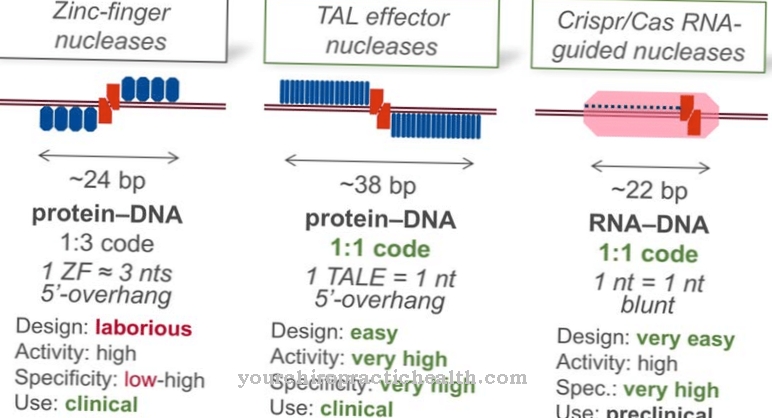Nicotinic acid/Nicotinic acid and Nicotinamide are also called niacin or Vitamin B3 designated. Both substances transform into each other in the body. As vitamin B3, nicotinic acid fulfills many important functions in the energy metabolism.
What is nicotinic acid?
Both nicotinic acid and nicotinamide are known as niacin or vitamin B3. In the organism they are subject to constant mutual transformation. Niacin is often ingested as nicotinamide with food and converted to nicotinic acid in the intestine. It is then also stored in the liver as nicotinic acid.
Nicotinic acid was previously known as Pellagra Preventing Factor (PPF), as a deficiency in vitamin B3 leads to pellagra disease. Today, however, this name is out of date. It is a chemical compound belonging to the heterocycle. The basic structure consists of a pyridine ring with a nitrogen atom in the aromatic ring to which a carboxyl group is attached. Nicotinic acid is a solid that forms colorless crystals. The melting point is 236.6 degrees Celsius. Like the other B-complex vitamins, nicotinic acid is water-soluble.
As a component of the coenzymes NAD and NADP, it is a hydrogen carrier and in this function is very important for the energy metabolism. Vitamin B3 must be taken in with food. The body can also produce small amounts of nicotinic acid from the amino acid tryptophan.
Function, effect & tasks
Nicotinic acid performs important functions in the body. Their most important function is to be responsible for reducing reactions through hydrogen transfer in the form of NAD and NADP. It is one of the most important reducing agents in the citric acid cycle and the respiratory chain.
Nicotinic acid is also involved in the regeneration of muscles, nerves, skin and DNA. In addition, it has an antioxidant effect that allows it to participate in many enzymatic reactions. Nicotinic acid or nicotinamide is also responsible for reducing blood lipids in the body. The need for vitamin B3 depends on the physical strain. The higher the energy consumption in the organism, the more nicotinic acid it needs. Vitamin B3 also has a great influence on the ability to remember and concentrate, as it positively stimulates nerve function.
Education, occurrence, properties & optimal values
Most of the vitamin B3 is absorbed through food. It often enters the body as nicotinamide. Once absorbed through the intestines, nicotinamide is converted to nicotinic acid and stored in the liver. Nicotinic acid can also be produced in the body itself in low concentrations. This happens through the breakdown of the amino acid tryptophan. Most foods contain niacin, although it is easier to absorb from animal products than from plant-based foods. Nicotinic acid occurs in relatively high concentrations in game, poultry, fish, mushrooms, eggs and dairy products.
High concentrations are also found in the liver, whole grain products, cashew nuts or coffee. Fruits and vegetables also contain nicotinic acid, although its utilization is somewhat more difficult than from animal foods. Vegans have a little more difficulty supplying the body with sufficient niacin, but with the consumption of peanuts, mushrooms, brewer's yeast, wheat bran, dates, dried apricots or legumes, they too can meet their vitamin B3 requirements. Some of these foods also contain a lot of tryptophan, from which niacin can then be synthesized in the body. As already mentioned, the need for niacin is also dependent on the body's energy requirements. With larger physical activities, the energy metabolism is also increased. This causes the greater need for nicotinic acid during physical activity, when breastfeeding or in pregnant women.
The average daily niacin requirement for the conversion of 1000 kilocalories is around 6.6 milligrams in adults. Women have an average daily requirement of between 13 to 15 milligrams and men a daily requirement of between 15 to 20 milligrams. Children need between 5 and 6 milligrams of vitamin B3 per day. A vitamin B3 deficiency is only of significance for population groups that eat one-sidedly on maize and millet products. In these plant-based foods, niacin is only released through a special processing method in such a way that it can be absorbed by the body.
Diseases & Disorders
Symptoms related to vitamin B3 deficiency can be serious. In extreme cases, the disease is referred to as pellagra. In our part of the world, vitamin B3 deficiency is rare, but in countries where the population mainly eats corn and millet products, vitamin B3 deficiencies can occur.
Pellagra was particularly common in southern Europe, Africa and North America after the Spanish conquest of Central America and the export of maize. The elaborate processing that the natives of Central America carried out was not taken over by the Spaniards. It was not until the beginning of the twentieth century that the connection between the main diet of corn and the disease was discovered. Pellagra manifests itself through severe skin changes, diarrhea, depression, inflammation of the mucous membranes of the mouth and stomach / intestines as well as memory disorders that can lead to dementia. Of course, absorption disorders in the intestine due to chronic bowel diseases can also lead to a vitamin B3 deficiency.
However, this also leads to deficiencies in other vitamins. An overdose of vitamin B3 does not cause any toxic effects. In individual cases, however, a vasodilator flush can occur, which at very high doses of over 2500 milligrams per day leads to dizziness, a drop in blood pressure and an increase in the level of uric acid in the blood. In drugs, nicotinic acid is often used in combination with other drugs to lower blood lipid levels.


.jpg)

























.jpg)